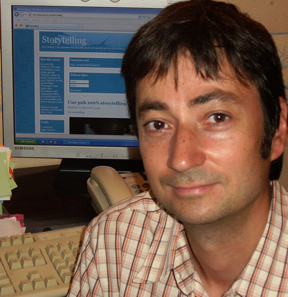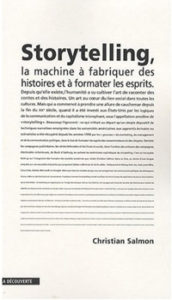
One of the special delights of this Q&A series is its international flavor. We’ve had Q&As from the UK, Canada, Denmark, Australia, Sweden (by way of UK) — have I missed any? — and now France. Stephane Dangel almost single-handedly upholds organizational storytelling in France and builds bridges from there to the worldwide storytelling community. Here is my Q&A with him.
Bio: Stephane Dangel has a background in political science, journalism, and communications. His interest in storytelling has derived from these activities, and he defines now himself as a “storytelling activist,” since organizational storytelling is still an emergent discipline in his country, France.
He has created the blog Storytelling which includes posts both in French and in English. Stephane teaches storytelling in business schools, is involved in projects dealing with the co-creation of stories within various environments, and is a keynote speaker in storytelling.
He’s also a writer; his forthcoming (fall 2009) book (in French) is Rires Post-mortem. It’s about stories — a collection of real-life events throughout the world and related to burials, coffins also. The pattern is that they are all funny stories.
Q: The storytelling movement seems to be growing explosively. Why now? What is it about this moment in human history and culture that makes storytelling so resonant with so many people right now?
A: We hear a lot about “narrative turn.” I don’t see storytelling as a turn, but as a story “to be continued.” Organizational storytelling is a modern form of the very ancient art of storytelling, adapted to contemporary needs. Storytelling is not a revolution, it has accompanied evolutions. As Robert McKee says, “stories are the currency of human relationships,” basically.
Marketing, management, and other disciplines integrate some structured narrative dimension because the focus is now on these disciplines as the focus was in bartering (with a strong narrative dimension) yesterday when bartering was the way things were going on in the world. So it’s somewhat natural.
Another dimension is related to “the quest for sense.” We hear a lot about the lack of sense. I think it’s more a lack of sense quest, because sense quest is complex and time spending. As storytelling is already deeply anchored into each of us, it’s a relatively low-cost solution to engage on sense quest. So it’s a solution for lazy people, but lazy, that’s what we are all, and it’s not negative. A problem occurs when corporations are extremely lazy, so they only grab and arrange stories in a database, instead of pursuing the quest till the patterns-finding stage.
Q: Are there any current uses of storytelling that repel you or that you feel are inappropriate?
A: Not everything is storytelling, but storytelling is able to be integrated in almost everything.
What I see, especially in France , is that some users in the political area have written the screenplay of a soap, and they even have already shot season 1, 2, 3, and more in advance. How could such a practice operate within an ever-changing world? It doesn’t fit the very basics of storytelling requirements. It’s like displaying, say today, an episode of a soap featuring Saddam Hussein, head of Iraq, as if he was still there. Irrelevant and ridiculous.
Q: What’s your favorite story about a transformation that came about through a story or storytelling act?
A: Here is the full (and long) story:
In the winter of 1954 in Paris, there was a man named Abbot Peter (Abbé Pierre) [pictured]. He was willing to launch some initiatives to help poor people, but nobody cared about that unknown guy. At this time, you got very low, minus temperatures in Paris. Abbot Peter managed to convince the biggest radio network to let him address a message to the population. So 20 millions French (half of the population) heard the message while being around the table for dinner.
Here are some excerpts from the message:
A woman has just died tonight, frozen, on the sidewalk of Boulevard Sebastopol in Paris. She was keeping in hand the paper by which she was expelled from her home two days ago. Each night, there are 2,000 persons who have no home, no bread to eat, some almost naked.
They need your help. In each Parisian borough, in each French town, boards have to be put under a light in the night, in front of houses where you can read. You, who suffer, whoever you are, come and sleep, eat, regain hope, here we love you. Weather channels announce terrible freezes for the next weeks. Thank you.
The most interesting fact is not that barely he had finished to address the message people began to act and help those poor people with great success, but the wave of collective innovation that followed after that emergency need for help.
While some weeks before, the government refused to take money to build homes for poor, this single story was sufficient to trigger what will be called “the revolution of Good,” whose actors were an anonymous team constituted by people from the whole country, who didn’t know each other but were united by the same spirit. The days following the radio message, money could be collected, people joined Abbot Peter, acting as a team. As a result, several organizations were created — an association called Emmaüs, a sub-division dedicated to the building of low-wages houses, the first non-profit organization dedicated to the defense of tenants, the creation of communities for homeless people where they could find a roof and a job (collecting old objects and reselling them)…
The Emmaüs organization still exists (Abbot Peter is now dead) and has an international scope, spreading in a lot of countries wolrdwide.
Q: You mention on Worldwide Story Work [a community of story practitioners focussed on the application of story-based techniques in organizational settings.] that you are “trying to expand storytelling in France.” What similarities and differences have you observed in the storytelling community in France and the storytelling community in the US ?
A: The “storytelling community in France” is for the moment… a fiction. We are only two bloggers running a blog dedicated to storytelling! There is only one and major book dedicated to storytelling in French, and it has been written by a man who hates storytelling (Christian Salmon: Storytelling)! His message is very raw: “storytelling = fiction = manipulation.”
So, building the storytelling community is a big task, trying to educate  people who don’t have the patience to read all the wonderful available resources in English, and reinsuring those who are tempted by storytelling but express doubts since they are hearing such “negative mess.”
people who don’t have the patience to read all the wonderful available resources in English, and reinsuring those who are tempted by storytelling but express doubts since they are hearing such “negative mess.”
I also see French focusing on marketing uses, knowing few about the analytical potentiality. This is also a real issue.
But we cannot let a guy like Christian Salmon establish himself as The Voice about storytelling in France, seeing the ideas he tries to infuse.
Q: You have undertaken some storytelling initiatives, such as a bilingual storytelling blog, a tag cloud fueled by 2009 storytelling resolutions, the newsletter (in French) that springs from your blog, and many discussions on Worldwide Story Work. To what extent do you feel these initiatives have succeeded? What has contributed to their success or lack of success? Do you have plans to make them more successful, and do you plan new initiatives?
 A: What I wanted to do is to prove that even an under-developed country (in the storytelling field), could contribute to the worldwide storytelling community. I’ve also launched the first Digg-like [site] dedicated to storytelling. I need to take care of it because after some good start, it has somewhat faded; I didn’t give enough time to it.
A: What I wanted to do is to prove that even an under-developed country (in the storytelling field), could contribute to the worldwide storytelling community. I’ve also launched the first Digg-like [site] dedicated to storytelling. I need to take care of it because after some good start, it has somewhat faded; I didn’t give enough time to it.
 I’m working on a method to elicit stories within conflictual situations and contexts which I’ve called “The I forgive…” method. I’ve already released a paper about it. I’m currently refining it, getting some advice especially from Cynthia Kurtz. I will release a completely new, expanded version as a chapter of a collective book to be released by mid-2010.
I’m working on a method to elicit stories within conflictual situations and contexts which I’ve called “The I forgive…” method. I’ve already released a paper about it. I’m currently refining it, getting some advice especially from Cynthia Kurtz. I will release a completely new, expanded version as a chapter of a collective book to be released by mid-2010.
What I expect from these initiatives is a reverse, boomerang-like effect in France, in addition to the somewhat “frontal attack” I’m implementing.
In addition, I’m working on some projects to organize training sessions in France, with trainers coming from the “expert countries,” hat is to say the anglo-saxon ones — sessions conducted by renowned storytelling consultants are good tools to expand storytelling in the country.







